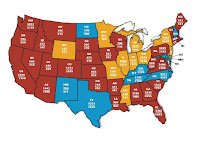You may be thinking about buying some distressed property as an investment. Now more than ever, there are great deals to be had in foreclosure properties, but if you are new to buying foreclosures, equip yourself with these insights that can protect you from clostly mistakes. Then do your homework, and
research the foreclosures in your area. And how to make sure that investment turns a profit requires knowing
how real estate property best results in a good investment.
4 Tricks and Traps Foreclosure Buyers Need to Know
Interest in buying a foreclosed home is on the rise, but so are concerns about the risk involved in the process. In a December survey, Trulia found that 49 percent of Americans were at least somewhat likely to consider buying a foreclosure, up from 45 percent in May 2010. But the number of US adults who believed there are disadvantages to buying foreclosures had also increased, from 78 percent to 81 percent over the same time frame. Among those folks who had qualms about purchasing a foreclosure, the top concerns were:
that buying a foreclosure might involve hidden costs, that the buying process itself is risky, and
that the home might continue to lose value, after escrow closes. While there certainly are risks that run with buying a foreclosed home, the most risky way to do it is also the least common method: at the foreclosure auction itself. Auction buyers often don't have the opportunity to fully vet the foreclosure to ensure that they are receiving clear title and/or to make sure they're not getting a lemon. With that said, most foreclosures are resold not at the foreclosure auction, but as an REO (short for Real Estate Owned - by the bank), listed by a real estate broker on the Multiple Listing Service and on Trulia!
When you buy an REO in this way, you have lots of opportunities to use some tricks of the trade, so to speak, to avoid some of the traps you may fear. Here are my Top 4 Tricks and Traps for Foreclosure Buyers:
1. As-is means as-is, period. (Most of the time.) Banks have very little interest, inclination or even the logistically necessary resources to execute repairs on your home. Many of these homes are managed by an asset management company in another state, and may not even have a local person besides the agent who can handle large repairs. Generally speaking, bank-owned homes are sold on a very strict "as-is, where-is" basis, which just means that you should expect to take possession of it, if you buy it, in exactly the position and location it is, no matter how defective. Do not walk into a viewing of a foreclosed home, notice how the plumbing is all ripped out of the wall, and make an offer for it, assuming you'll be able to get the bank to "fix" the issue later. Usually, if the bank is willing to do any repairs to a foreclosed home, they do so, on the advice of the listing agent, prior to the home being listed.
Out of hundreds of foreclosure transactions I have personally been involved in, I have seen exactly four where the bank did agree to do some level of repairs at a buyer's request. Every one of those times, the repair was to fix a health-and-safety endangering property defect, like a gas-leak or an electrical fritz. And every one of those times, the property defect was highly non-obvious - not something even a diligent buyer could have detected visually prior to making an offer. Maybe another few times I've seen a bank agree to a small price reduction due to surprising condition problems. And dozens of times, I've seen transactions fall apart or buyers take on the property’s repair costs, when they request repair credits, price reductions or actual repairs from the ban seller.
If a foreclosure you're considering has obvious property damage, have your contractor stop by with you or gather whatever information you need to get as comfortable as possible with your offer price, assuming that the bank will not be chipping anything in for repairs, before you make the offer.
2. The bank speaks no evil. When it comes to real estate disclosures, the fact is, the bank speaks not much of anything! Many states exempt banks and other types of corporate homeowners from making substantive disclosures about the condition of the property. Even in jurisdictions where the bank is not legally exempt, most banks will simply write across the required disclosures something to the effect that the bank has no knowledge of the property's condition. (Before you protest with a "that's not fair!!" keep in mind that the bank never lived in the property, so most often truly does have no idea of any important facts or details about its condition or location, the things an average home seller would be required to disclose.)
Even in a normal transaction, it behooves a buyer to be thorough in having the property inspected and meticulous about reviewing the resulting inspection reports. But buying a foreclosure ups even that ante, as you have no seller disclosures to highlight particular problems you should have looked at, and none of the usual legal recourse you would have if a “regular” seller made incomplete disclosures. Get a property inspection. A pest inspection. A roof inspection. A sewer line inspection. A pool inspection, if you have a pool and care about its condition.
Yes - all these inspections cost money, but the drama and thousands each of them can save you is well worth it. And read your state’s buyer inspection advisory or similar document (ask your agent), just to make sure you’re aware of all the inspections that are available to you, and work with your agent to determine which ones make sense, and which are not appropriate.
Some insider tips:
Vacant foreclosures often have their utilities disconnected. Work with your agent to make sure the utilities get turned on - even for a single day - so that your property inspector can run the water taps, test the stove and dishwasher, see if the water heater and electrical outlets work, and so forth.
If appliances are there, the bank will probably leave them there, even though they may not have technical “legal” ownership of them, so they may not be included in the contract, like in a "normal" home sale.
However, the bank will not give you any sort of warranty on appliances, so try to obtain any warranty coverage you want or need elsewhere - from a home warranty company or, potentially, the original manufacturer/retailer.
3. The contract terms, they are a changin'. One thing squarely in the wheelhouses of local real estate pros are local market standard practices. From negotiating practices to which party pays which closing costs, every market is different, and experienced local agents are experts on this information. If you’re buying a foreclosure, though, the bank will often require you to use it’s own purchase contract, rather than the more commonly used state forms. Many times, this is done to advise the buyer of the bank’s refusal to make substantive disclosures (see above) and to change some of the normal practices for your area to the bank’s standard practices.
For instance, if you are buying a home in a contingency state, where you would usually have to sign a document proactively releasing contingencies, the bank’s contract will probably change that, so that your transaction operates on an objection period. In "objection" based transactions, you have a certain period of time in which you must either speak up about your concerns with the property and/or cancel the deal, or you will automatically be presumed to be moving forward with the deal and your deposit money will be forfeited if you change your mind after that date.
If you’ve been making offers on non-foreclosures on the standard contract form, or you’ve bought homes before and think you know the drill, please - I implore you - READ every word of the contract you sign when you buy a home from the bank, and ask your broker,
agent or attorney to explain anything that doesn’t make sense.
4. Expect the unexpected. When you buy a foreclosure, you might end up working with the bank’s escrow company, instead of a company you or your agent selects. And the bank's escrow provider might be slow or disorganized. C’est la vie. The bank might rush you for your deposit money, but take their own sweet time coming up with the necessary signatures on their end to close the deal. Par for the course. You might expect that the bank would be desperate for buyers, and instead find out that there are 20 offers on the same REO. Or, you might be the only offer and still get your aggressively low (but still reasonable) offer rejected, only to have the bank reduce the list price of the home to the same price of your offer! (They often want to see if exposing it to other buyers at the new, lower list price might generate more interest and higher offers.)
When you’re buying a foreclosure, expect glitches, expect your calendar to be derailed, expect the bank to be inflexible and possibly even unreasonable. It’s not overkill to ask your broker or agent to brief you on the common complications they see in REO transactions. Having realistic expectations may keep you from pulling your hair out. And if the transaction turns out to run smooth as silk? You’ll be pleasantly surprised.
So remember that, like anything else, becoming a highly profitable foreclosure investor requires some experience and know-how. The market is ripe with opportunity, however, so if you desire to take advantage to current opportunities, then have the confidence in knowing that a seasoned real estate agent can help you navigate these foreclosure waters. If you have any questions about foreclosures anywhere around the Houston and Southeast Texas region,
contact Lauri Kent. Also visit the website for more information about Lauri Kent and her team of real estate professionals.
















